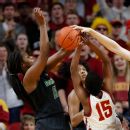8:02 am | February 25, 2019 | Go to Source | Author:
Since the start of ESPN’s women’s bracketology 15 years ago, the phrase “subject to change” has never been more appropriate. No. 1 seeds have never been so up in the air this late in the season. Some weekends, teams are shifting on and off the bubble by the hour. The fight to be in the top 16 seeds and host first- and second-round games is even more contentious than the battle for a No. 1 seed.
So, with three weeks until Selection Monday, and one week left in the regular season in most of the Power 5 conferences, what questions have been answered and what’s still to come?
What we know
Six teams have a chance to be a No. 1 seed: That might seem like a small number, but by this time during most years, the four No. 1 seeds are virtual locks or three of the four are well-established. Never has there been six truly worthy candidates with just three weeks left on the clock. Through Sunday’s games, Baylor, Louisville, UConn and Notre Dame are the choice in this week’s bracketology — and there shouldn’t be much debate, due to recent losses by Oregon and Mississippi State. If the Ducks and Bulldogs don’t lose again, they would have a strong claim to a top seed.
UConn to Albany and Oregon to Portland: Whether they end up as No. 1 or No. 2 seeds, count on the Huskies playing in the Albany Regional and the Ducks staying in their home state. With the way the committee assigns regional placement based on a team’s position on the S-curve, there is no scenario in which both UConn and Oregon finishing in the top six puts them in any other region.
All hail these five mid-majors: Gonzaga, Drake, South Dakota State, South Dakota and Central Michigan are making the field. They already have put together NCAA tournament-worthy seasons.
That also means these are the teams for which those on the bubble need to root for during conference tournament play. For instance, if South Dakota or South Dakota State doesn’t win the Summit League tournament, then three teams from that conference will be going to the NCAA tournament and another at-large spot is gone, because both the Coyotes and Jackrabbits have a spot should they not get the automatic bid.
At one point, it appeared the Mid-American Conference would get multiple bids, but that’s not as certain today if Central Michigan wins the MAC tournament. Should the Chippewas pull that off, another spot opens up; the same holds true if Drake can claim the Missouri Valley Conference tourney.
Bubble teams such as Auburn, LSU, Indiana, West Virginia, Kansas State and Butler might need as many open slots as possible.
What we don’t know
Will Louisville or Notre Dame go to Chicago? The Fighting Irish heading to the Windy City is not a done deal, even if Notre Dame is a No. 1 seed. The NCAA selection committee values a team’s ability to bus rather than fly whenever possible. Both the Cardinals and Irish can bus to Wintrust Arena. So, if Louisville wins the ACC tournament in a close final over Notre Dame, but the Irish are still a No. 1 seed, the Cardinals would still be ahead of the Irish on the S-curve and, thus, be placed in the bracket first. That means Louisville would get put in Chicago, pushing Notre Dame somewhere else, likely Portland. So, keep a close eye on the Cardinals and Irish in the ACC tournament. Whichever team wins the title — or goes furthest in the competition, if neither wins the ACC tourney — will likely be in the Chicago Regional.
How will the committee view injuries in its decision-making for the No. 1 seeds? Jackie Young was sidelined in one of Notre Dame’s three losses. Ruthy Hebard missed most of the game when Oregon fell at Oregon State, and she sat out the Ducks’ loss to UCLA. Unlike some other injured players (Chloe Bibby at Mississippi State or Grace Hunter — among others — at NC State, for example), Young and Hebard are back, and their teams are whole again and presumably will be when the NCAA tournament rolls around.
Evaluation of key players missing time is a subjective element to the process, so it’s not clear if the committee will weigh those losses — the ones that could be the difference between a No. 1 or No. 2 seed — the same as others. Even if they are viewed differently, will that view be enough to offset the loss itself or at least minimize it in the eyes of some committee members? We might not know that answer until Selection Monday.
How will the top-16 race shake out? About 19 teams are in the mix, with nine likely being locks. That leaves 10 teams for seven spots. This also is a rarity to have so much potential fluidity this late in the season.
Miami did itself a huge favor by beating Florida State on Sunday, which also knocked the Seminoles out of serious contention. South Carolina’s win over Tennessee also boosted the Gamecocks. Syracuse would vault itself into the top 16 (and help make the debate over which teams should be a No. 1 seed easier) with an upset of Notre Dame on Monday (ESPN, 6 p.m. ET). Like the Orange, Kentucky and Texas A&M look to be just barely on the outside looking in, but with worthy résumés; the loser of their Thursday matchup in Lexington probably will see the chance to host disappear.
Powered by WPeMatico



